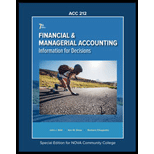
Concept explainers
Free on board:
Free on Board in short known as FOB, defines whether a buyer or a seller will be responsible for the ownership of the goods based on the geographical location of the goods and the contract entered there in. There are two types of FOB –FOB Shipping and FOB Destination.
FOB shipping: Under this contract when the goods are placed at the port for the shipment, the ownership of the goods transfers to the buyer. And now the buyer will incur the expenses (freight expense or the transportation expense) or even the loss if anything happens to the goods, from the point of goods placed for delivery.
FOB destination: Under this contract until the goods does not reaches the delivery point of the buyer, the ownership of goods remain with the seller. Thus the seller will incur the expense or the loss if anything happens to the goods before being delivered to the buyer at the stated delivery location.
Inventory: Inventory refers to the stock or goods which will be sold in the near future and thus is an asset for the company. It comprises of the raw materials which are yet to be processed, the stock which is still going through the process of production and it also includes completed products that are ready for sale. Thus inventory is the biggest and the important source of income and profit for the business.
Consignment: Consignment is an agreement between the seller and the agent wherein the agent takes the responsibility of selling the goods on the seller‘s behalf to the buyer or the third party though the ownership of the goods remains with the seller until goods are sold to the actual buyer.
Consignor: The one who discharges the duty of selling the products to the ultimate buyer to an agency or an agent is known as the consignor.
Consignee: The one who works as an agent for a seller and takes the responsibility to vend or sell the goods by charging commission for the same is the consignee.
To identify: 1.The closing inventory amount to be included in the
2. Consignor and consignee in case of the two companies and the company which will include the unsold goods as a part of its inventory
Want to see the full answer?
Check out a sample textbook solution
Chapter 5 Solutions
FIN & MANAGERIAL ACCT VOL 2 W/CONNECT
- Compare and contrast the procedures for lodging an objection in Jamaica with those of Trinidad and Tobago.arrow_forwardThe actual cost of direct labor per hour is $16.25 and the standard cost of direct labor per hour is $15.00. The direct labor hours allowed per finished unit is 0.60 hours. During the current period, 4,500 units of finished goods were produced using 2,900 direct labor hours. How much is the direct labor rate variance? A. $3,625 favorable B. $3,625 unfavorable C. $4,350 favorable D. $4,350 unfavorablearrow_forwardOn January 1 of the current year, Piper Company issues a 4-year, non-interest-bearing note with a face value of $8,000 and receives $4,952 in exchange. The recording of the issuance of the note includes a: a. credit to Notes Payable for $4,952. b. credit to Discount on Notes Payable for $3,048. c. debit to Discount on Notes Payable for $3,048. d. debit to Cash for $8,000.arrow_forward
- During September, the assembly department completed 10,500 units of a product that had a standard materials cost of 3.0 square feet per unit at $2.40 per square foot. The actual materials purchased consisted of 22,000 square feet at $2.60 per square foot, for a total cost of $57,200. The actual material used during this period was 25,500 square feet. Compute the materials price variance and materials usage variance.arrow_forwardBluesy Electronics recorded the following financial data: Net Sales $720,500 Average Inventory at Cost = $80,200 Gross Margin Percentage = 42% Calculate the GMROI.arrow_forwardNeed help this question solutionarrow_forward

 AccountingAccountingISBN:9781337272094Author:WARREN, Carl S., Reeve, James M., Duchac, Jonathan E.Publisher:Cengage Learning,
AccountingAccountingISBN:9781337272094Author:WARREN, Carl S., Reeve, James M., Duchac, Jonathan E.Publisher:Cengage Learning, Accounting Information SystemsAccountingISBN:9781337619202Author:Hall, James A.Publisher:Cengage Learning,
Accounting Information SystemsAccountingISBN:9781337619202Author:Hall, James A.Publisher:Cengage Learning, Horngren's Cost Accounting: A Managerial Emphasis...AccountingISBN:9780134475585Author:Srikant M. Datar, Madhav V. RajanPublisher:PEARSON
Horngren's Cost Accounting: A Managerial Emphasis...AccountingISBN:9780134475585Author:Srikant M. Datar, Madhav V. RajanPublisher:PEARSON Intermediate AccountingAccountingISBN:9781259722660Author:J. David Spiceland, Mark W. Nelson, Wayne M ThomasPublisher:McGraw-Hill Education
Intermediate AccountingAccountingISBN:9781259722660Author:J. David Spiceland, Mark W. Nelson, Wayne M ThomasPublisher:McGraw-Hill Education Financial and Managerial AccountingAccountingISBN:9781259726705Author:John J Wild, Ken W. Shaw, Barbara Chiappetta Fundamental Accounting PrinciplesPublisher:McGraw-Hill Education
Financial and Managerial AccountingAccountingISBN:9781259726705Author:John J Wild, Ken W. Shaw, Barbara Chiappetta Fundamental Accounting PrinciplesPublisher:McGraw-Hill Education





